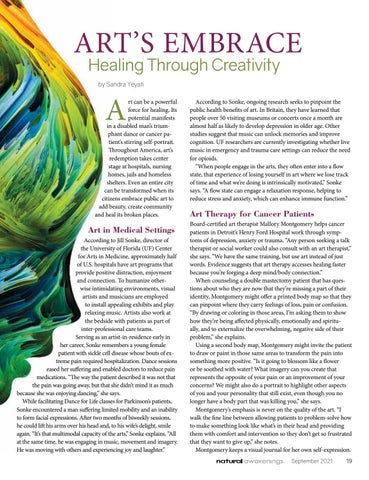ART’S EMBRACE Healing Through Creativity by Sandra Yeyati
A
rt can be a powerful force for healing. Its potential manifests in a disabled man’s triumphant dance or cancer patient’s stirring self-portrait. Throughout America, art’s redemption takes center stage at hospitals, nursing homes, jails and homeless shelters. Even an entire city can be transformed when its citizens embrace public art to add beauty, create community and heal its broken places.
Art in Medical Settings According to Jill Sonke, director of the University of Florida (UF) Center for Arts in Medicine, approximately half of U.S. hospitals have art programs that provide positive distraction, enjoyment and connection. To humanize otherwise intimidating environments, visual artists and musicians are employed to install appealing exhibits and play relaxing music. Artists also work at the bedside with patients as part of inter-professional care teams. Serving as an artist-in-residence early in her career, Sonke remembers a young female patient with sickle cell disease whose bouts of extreme pain required hospitalization. Dance sessions eased her suffering and enabled doctors to reduce pain medications. “The way the patient described it was not that the pain was going away, but that she didn’t mind it as much because she was enjoying dancing,” she says. While facilitating Dance for Life classes for Parkinson’s patients, Sonke encountered a man suffering limited mobility and an inability to form facial expressions. After two months of biweekly sessions, he could lift his arms over his head and, to his wife’s delight, smile again. “It’s that multimodal capacity of the arts,” Sonke explains. “All at the same time, he was engaging in music, movement and imagery. He was moving with others and experiencing joy and laughter.”
According to Sonke, ongoing research seeks to pinpoint the public health benefits of art. In Britain, they have learned that people over 50 visiting museums or concerts once a month are almost half as likely to develop depression in older age. Other studies suggest that music can unlock memories and improve cognition. UF researchers are currently investigating whether live music in emergency and trauma care settings can reduce the need for opioids. “When people engage in the arts, they often enter into a flow state, that experience of losing yourself in art where we lose track of time and what we’re doing is intrinsically motivated,” Sonke says. “A flow state can engage a relaxation response, helping to reduce stress and anxiety, which can enhance immune function.”
Art Therapy for Cancer Patients Board-certified art therapist Mallory Montgomery helps cancer patients in Detroit’s Henry Ford Hospital work through symptoms of depression, anxiety or trauma. “Any person seeking a talk therapist or social worker could also consult with an art therapist,” she says. “We have the same training, but use art instead of just words. Evidence suggests that art therapy accesses healing faster because you’re forging a deep mind/body connection.” When counseling a double mastectomy patient that has questions about who they are now that they’re missing a part of their identity, Montgomery might offer a printed body map so that they can pinpoint where they carry feelings of loss, pain or confusion. “By drawing or coloring in those areas, I’m asking them to show how they’re being affected physically, emotionally and spiritually, and to externalize the overwhelming, negative side of their problem,” she explains. Using a second body map, Montgomery might invite the patient to draw or paint in those same areas to transform the pain into something more positive. “Is it going to blossom like a flower or be soothed with water? What imagery can you create that represents the opposite of your pain or an improvement of your concerns? We might also do a portrait to highlight other aspects of you and your personality that still exist, even though you no longer have a body part that was killing you,” she says. Montgomery’s emphasis is never on the quality of the art. “I walk the fine line between allowing patients to problem-solve how to make something look like what’s in their head and providing them with comfort and intervention so they don’t get so frustrated that they want to give up,” she notes. Montgomery keeps a visual journal for her own self-expression. September 2021
19
